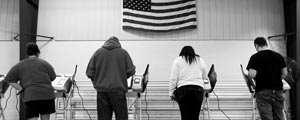A novelty 50 years ago, televised presidential debates are now the centerpiece of the general election phase of the campaign and considered a linchpin in winning the presidency. Debates have become the Super Bowl of the race for the White House, with candidates performing not only for the tens of millions of potential voters tuning in, but also for the millions more who may be influenced by secondary coverage days later. Given the closeness of the 2016 race in the latest polls, this year's debates could be as important to the outcome as the 1960 debates when John F. Kennedy's mastery of the medium helped him convert a slight deficit in the polls to a squeaker of an election victory over Richard Nixon.
An estimated 70 million viewers watched the first televised debate in 1960 (which lasted only 60 minutes). Since that time, the concept of televised, face-to-face debates has become an American institution. Abraham Lincoln and Stephen Douglas would be proud if they could see what they started in 1858, when their own debates elevated public awareness of the deepest issues of that age. Teddy White, in his historical treatise on the Kennedy/Nixon campaign, said, "Televised debates make for the simultaneous gathering of all the tribes of America to ponder their choice between two chieftains in the largest political convocation in the history of man."
Given the high public interest we saw in this year's primary season debates, the three upcoming presidential debates will likely attract record audiences. These are the last major events left in a campaign that has already hooked Americans on high political drama. If the potential for something thrilling, outrageous or unprecedented to happen at the debates doesn't get voters to tune in, the importance of measuring up these two very different candidates -- in a year when voters don't have the default choice of an incumbent to fall back on -- might.
Reviewing the last two non-incumbent presidential elections of 2000 and 2008 shows how viewership can differ depending on public interest. According to Nielsen Media Research, approximately 47 million viewers watched the first presidential debate in 2000 between George W. Bush and Al Gore. But the numbers dropped to 38 million for the second and third debates that year. By contrast, in 2008, viewership swelled from 52 million for the first debate to 63 million for the second, and remained fairly high at 57 million for the third.
| 2000 | 2008 | ||||||||||||||||||||||||||||||||||||||||||||||||||||||||||||||||||||||||||||||||||||||||||||||||||
|---|---|---|---|---|---|---|---|---|---|---|---|---|---|---|---|---|---|---|---|---|---|---|---|---|---|---|---|---|---|---|---|---|---|---|---|---|---|---|---|---|---|---|---|---|---|---|---|---|---|---|---|---|---|---|---|---|---|---|---|---|---|---|---|---|---|---|---|---|---|---|---|---|---|---|---|---|---|---|---|---|---|---|---|---|---|---|---|---|---|---|---|---|---|---|---|---|---|---|---|
| First debate | 47 million | 52 million | |||||||||||||||||||||||||||||||||||||||||||||||||||||||||||||||||||||||||||||||||||||||||||||||||
| Second debate | 38 million | 63 million | |||||||||||||||||||||||||||||||||||||||||||||||||||||||||||||||||||||||||||||||||||||||||||||||||
| Third debate | 38 million | 57 million | |||||||||||||||||||||||||||||||||||||||||||||||||||||||||||||||||||||||||||||||||||||||||||||||||
| Nielsen Media Research | |||||||||||||||||||||||||||||||||||||||||||||||||||||||||||||||||||||||||||||||||||||||||||||||||||
To put this in perspective, the number of Americans watching the Super Bowl -- an event that has become a national cultural phenomenon -- averages more than 100 million viewers. While no presidential debate has attained that level of ratings so far, according to Nielsen, 81 million Americans tuned in to the final debate between Jimmy Carter and Ronald Reagan in 1980. In terms of viewership, that is followed by the 70 million who tuned in for the first debate between Carter and Gerald Ford in 1976, as well as the 70 million who viewed the second debate among George H.W. Bush, Bill Clinton and Ross Perot in 1992. A second perspective to keep in mind is that about 130 million Americans voted in the 2012 presidential election. Thus, roughly half of likely voters watch the debates, and it's likely that most wind up seeing at least one per election year.
The 2012 debate audiences were higher than average. Even if the 2016 debates attract no more than a similar level of viewers, their influence on the outcome of the election could be enormous.
We tend to think that presidential debates are just about issues and facts, with self-appointed experts attempting to rate each candidate's performance by "points," or by focus groups often moderated with excessive subjectivity. However, while some viewers will want to hear policy positions and rebuttal facts, others will want to gauge each candidate's true self in an unscripted, face-to-face situation. They will form such judgments about the candidates' temperaments as "cool" or "angry," as the contenders will now be fully exposed to voters who want to feel like they know the candidates from the comfort of their own homes. Going face to face on a national stage allows no place to hide. The smallest gesture could come across as awkward or playful; the briefest utterance might set a campaign on the path to victory or defeat.
In terms of issues and policy positions this year, it is my belief that a large proportion -- perhaps as much as half -- of the national audience will want to hear about the leading domestic and foreign policy issues facing the country: strengthening the U.S. economy and keeping the country safe from terrorism. However, others will hope the discussion goes more into the weeds, with time allocated to second-tier issues such as immigration, Second Amendment rights, the national debt and healthcare policy, among others. There is also a third tier of issues encompassing climate change, abortion, Supreme Court nominations, etc. But because of the sharp partisan differences that exist on such issues, these would mainly factor into the broad entertainment value of the debate, and not the substance.
How much do debates matter? Looking at Â鶹´«Ã½AV trial-heat data before the first presidential debate in 2000, Bush trailed Gore on the ballot question 39% to 47% -- but after the first debate, the race shifted to dead even (43% to 43%). After the third and final debate, Bush maintained his new support in Â鶹´«Ã½AV polling (44% pre-debate, 46% post-debate), while Gore lost some of his support (from 44% to 42%), foreshadowing the extremely close election in November (the actual election was three weeks after the final debate). Thus, ballot measurement after these three debates in 2000 showed evidence of voters' shifts that seemed to solidify Bush's support, while Gore's support declined some.
Â鶹´«Ã½AV evaluated the debates somewhat differently in 2008, concentrating on Americans' self-reports of whether their views of each candidate became more favorable or less favorable after the debates. The results, with Barack Obama's "more favorable" rating climbing seven percentage points throughout the debate process, demonstrated that Obama effectively used the debates to burnish his personal image and leadership style -- the key to his eventual success -- rather than just convey his command of "issues and facts." John McCain actually lost considerable favor during the course of the 2008 debates, which was his undoing. Airing toward the end of the campaign season, the debates gave Obama undeniable momentum that carried through to the election.
| Barack Obama | John McCain | |||||||||||||||||||||||||||||||||||||||||||||||||||||||||||||||||||||||||||||||||||||||||||||||||||
|---|---|---|---|---|---|---|---|---|---|---|---|---|---|---|---|---|---|---|---|---|---|---|---|---|---|---|---|---|---|---|---|---|---|---|---|---|---|---|---|---|---|---|---|---|---|---|---|---|---|---|---|---|---|---|---|---|---|---|---|---|---|---|---|---|---|---|---|---|---|---|---|---|---|---|---|---|---|---|---|---|---|---|---|---|---|---|---|---|---|---|---|---|---|---|---|---|---|---|---|---|
| First debate | ||||||||||||||||||||||||||||||||||||||||||||||||||||||||||||||||||||||||||||||||||||||||||||||||||||
| More favorable | 30% | 21% | ||||||||||||||||||||||||||||||||||||||||||||||||||||||||||||||||||||||||||||||||||||||||||||||||||
| Less favorable | 14% | 21% | ||||||||||||||||||||||||||||||||||||||||||||||||||||||||||||||||||||||||||||||||||||||||||||||||||
| Net favorable | +16 | 0 | ||||||||||||||||||||||||||||||||||||||||||||||||||||||||||||||||||||||||||||||||||||||||||||||||||
| Second debate | ||||||||||||||||||||||||||||||||||||||||||||||||||||||||||||||||||||||||||||||||||||||||||||||||||||
| More favorable | 34% | 12% | ||||||||||||||||||||||||||||||||||||||||||||||||||||||||||||||||||||||||||||||||||||||||||||||||||
| Less favorable | 12% | 33% | ||||||||||||||||||||||||||||||||||||||||||||||||||||||||||||||||||||||||||||||||||||||||||||||||||
| Net favorable | +22 | -21 | ||||||||||||||||||||||||||||||||||||||||||||||||||||||||||||||||||||||||||||||||||||||||||||||||||
| Third debate | ||||||||||||||||||||||||||||||||||||||||||||||||||||||||||||||||||||||||||||||||||||||||||||||||||||
| More favorable | 37% | 21% | ||||||||||||||||||||||||||||||||||||||||||||||||||||||||||||||||||||||||||||||||||||||||||||||||||
| Less favorable | 15% | 29% | ||||||||||||||||||||||||||||||||||||||||||||||||||||||||||||||||||||||||||||||||||||||||||||||||||
| Net favorable | +22 | -8 | ||||||||||||||||||||||||||||||||||||||||||||||||||||||||||||||||||||||||||||||||||||||||||||||||||
| Â鶹´«Ã½AV | ||||||||||||||||||||||||||||||||||||||||||||||||||||||||||||||||||||||||||||||||||||||||||||||||||||
Bottom Line
The three scheduled presidential debates, starting on Sept. 26, will most likely be the last critical events of the 2016 election, and record audiences are expected. There could be "lightning in a bottle" if either candidate grossly missteps, seems to unravel or is dominated by his or her opponent. These debates offer an opportunity not only for the candidates to secure their fate, but also for a record-high number of Americans to experience the excitement of the days of Lincoln and Douglas.



